Turmeric is easy enough to pick up at the grocery store, certainly, but when one has ready access to freshly grown turmeric it’s easy to make turmeric powder at home. Learning how to make turmeric powder ensures the freshest results and good quality turmeric for all of your recipes.
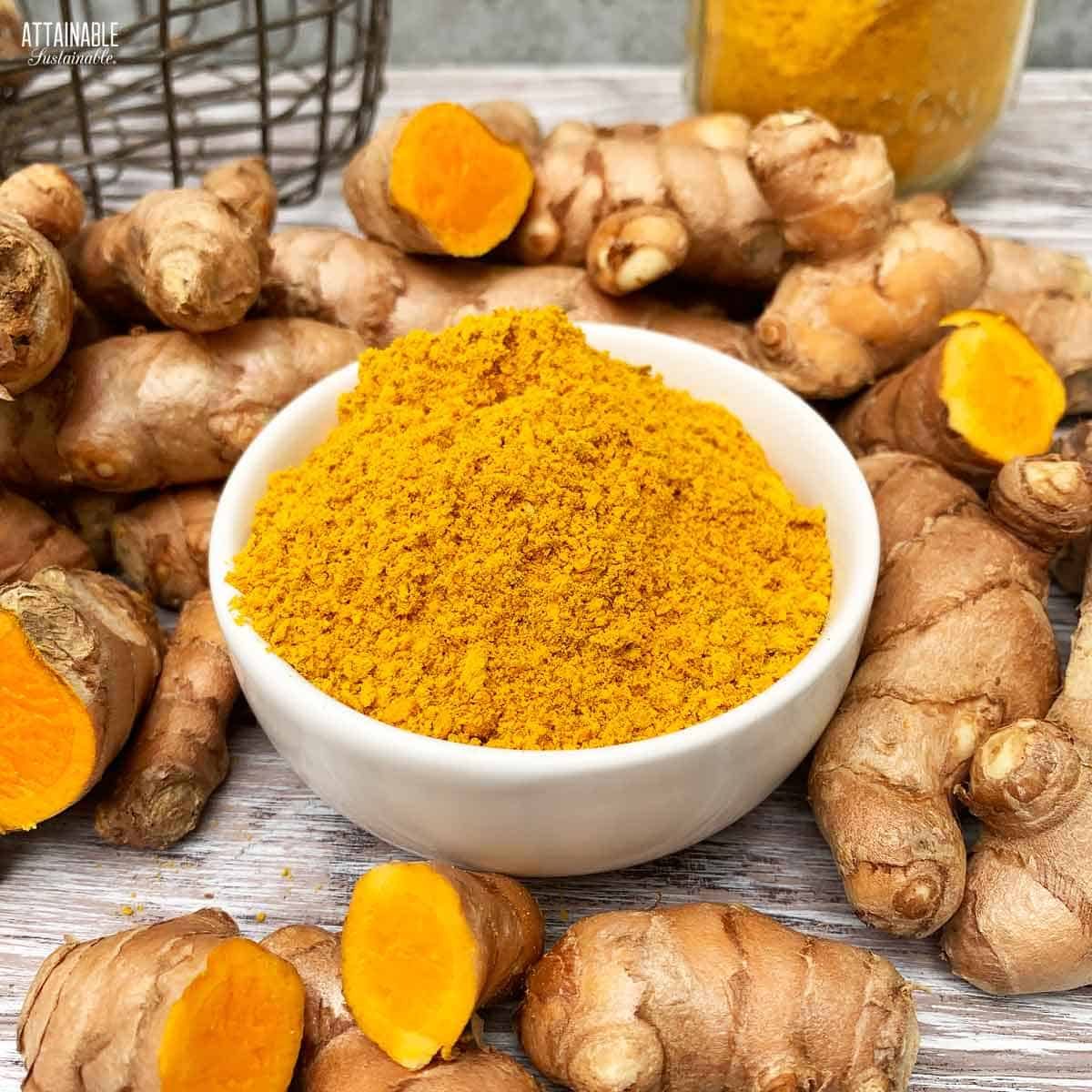
Love the idea of making your own spices? Here’s how to make your own red pepper flakes!
Fresh turmeric (curcuma longa) roots are similar to ginger — in fact, it’s part of the ginger family — but the roots are a bit smaller. And much more orange. Just look at that bright color! The fresh root will stain surfaces a bright yellow, especially porous surfaces. This is true of turmeric powder, as well.
Anti-Inflammatory Turmeric
By now, we’ve all heard about turmeric and its anti-inflammatory properties, right?
The National Library of Medicine says this of its medicinal properties:
Turmeric’s effects on health are generally centered upon an orange-yellow colored, lipophilic polyphenol substance called “curcumin,” which is acquired from the rhizomes of the herb. Curcumin is known recently to have antioxidant, anti-inflammatory, anticancer effects and, thanks to these effects, to have an important role in prevention and treatment of various illnesses…
5 Easy Steps to Transform Your Pantry!
Ready to switch from store bought to homemade? Let me help you make some changes! Grab my FREE five-part guide to getting started.
The Handcrafted Pantry

Ready to DIY your pantry with more wholesome ingredients? Check out my ebook, The Handcrafted Pantry! Filled with delicious recipes for some of your favorite condiments, snacks, and toppings, it’s the guide you need to start skipping packaged products and embrace homemade.
Ingredients for Fresh Turmeric Powder
Your best bet for finding turmeric root is at an ethnic food store, though you may be able to order it online as well. Once you’ve acquired fresh turmeric rhizomes, be sure to set a few aside so you can start growing your own!
This plant typically grows in tropical regions, but gardeners in less temperate regions can grow it in a pot, which allows you to protect the plant from cold weather and extend the growing season. Learn how to grow a turmeric plant.
How to Dry Turmeric Root
Spoiler: It’s easy.
To make turmeric powder, you’ll need to remove all of the moisture from the turmeric fingers. (And indeed, they do look like fingers!)
This is achieved by slicing the turmeric thinly, and then dehydrating it. I use a dehydrator, but this can certainly be done in an oven set to low as well.
There’s no need to peel the raw turmeric root if it’s fresh. A stiff scrub brush will remove residual dirt as well as some of the soft skins. If you do want to remove the skin, the easiest way to do so is by scraping the root with the side of a spoon.
Once clean, slice fresh turmeric root into uniform thickness. I used my food processor, but a mandoline would work, as would a knife. The thinner the slices, the faster they’ll dry in the dehydrator.
Using a Dehydrator
A food dehydrator is a specialized appliance specifically made for drying fruits, veggies, and meat. They come in a variety of shapes and sizes, but all include a number of trays that allow warm air to freely circulate.
This is my preferred method of drying produce. My 9-tray Excalibur dehydrator holds the largest amount of produce out of all three of the methods listed here, making the most of the energy used to dry them.
Place turmeric slices in a single layer, fitting as many as you can without overlapping, on the dehydrator trays and dry at 135ºF for 5-7 hours.

Fill the trays of a dehydrator without allowing too much of the root to overlap.
Oven Drying
Drying turmeric in the oven utilizes equipment most people already have on hand. It’s not the most energy-efficient method, but it does the trick in a pinch.
Set the oven to a low temperature. 135ºF is the ideal, but not all ovens offer that precise low heat. If you have an oven with a bread proofing setting you can try that. Older ovens that only go as low as 200ºF can be used, but you’ll need to prop the oven door open.
Place sliced turmeric on a wire rack on a baking sheet. This allows the air to flow around the slices. Alternatively, you can line each baking tray with parchment paper.
The amount of time required for oven drying will vary depending on the temperature you are able to use.
Sun Drying
In warm, dry regions, you can try your hand at sun-dried turmeric. Prepare the turmeric as for oven drying and place the trays outside out of direct sunlight. Cover with a light tea towel or a layer of cheesecloth to prevent insects from landing on the food.
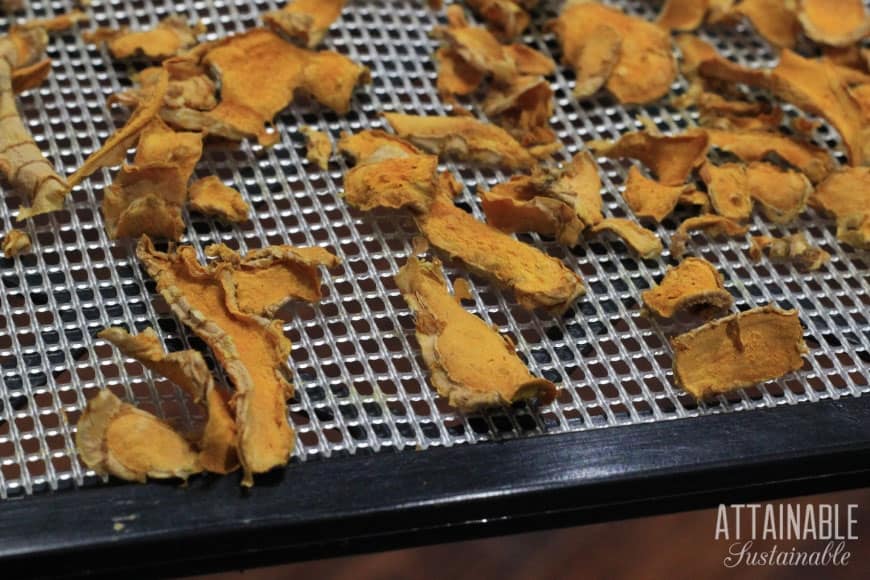
The turmeric root loses its bright yellow color once dried.
Checking for Doneness
Be sure to dry it until it’s crispy and cracks easily in two when you bend it. This assures that the moisture content is low enough for long-term storage.
Processing the Dried Turmeric Root
When you’ve achieved the right level of dryness, transfer the dried turmeric to a blender or spice grinder and process until it’s a fine powder. You may want to sift out the finest powder and reprocess the larger bits.
You can also pulse to create small pieces of turmeric that are just shy of a powder. These make a good addition to tea blends.
Storage
Store the dried root, powder, or pieces in an airtight container in a dry place. If you live in a humid region, as I do, these homemade desiccant packs can extend the shelf life of your homemade turmeric powder.
FAQs
Do I need to peel turmeric before consuming?
The peel is completely edible. You can scrub it or peel it, or do nothing beyond washing the turmeric root. I’m all for saving time in the kitchen, so I scrub well so any dirty or loose peel comes off but I don’t necessarily peel every last bit off.
How long can I store turmeric powder?
Purchasing or making desiccant packs is ideal for storage. You can also vacuum seal or use self-sealing mylar bags as well. Only leave out enough that you can use in a reasonable amount of time so the remainder stays fresh. I’d say the best potency is about a year, especially if you store it carefully.
Does turmeric stain?
You can wear gloves when processing turmeric, as it will stain much like when working with beets. Protect your work surface with an old towel or a baking sheet. Keep in mind that your food processor or other equipment may also be stained by this!
Do I need to use a dehydrator?
Drying the turmeric in a dehydrator uses a lower, gentler heat than using the oven, though it does take longer. You can use the oven if you don’t have a dehydrator or have less time. It is still a low enough heat to not destroy the health benefits of turmeric. Some people even dry their turmeric root in the sun, but it can take as long as two weeks! And if you live where it’s humid as I do, I don’t think it would ever dry out completely.
Using Turmeric Powder
- Add it to this easy curry powder
- Jazz up chicken noodle soup
- Make golden milk
- Stir some into this homemade green onion dip
- Use it as a dye
- Turmeric milk
- Add it to your homemade mustard recipe
- Make this turmeric body scrub for smooth skin
★ Did you make this recipe? Don’t forget to give it a star rating below! ★

Making Turmeric Powder from Fresh Roots
Ingredients
- 4 cups turmeric rhizomes
Instructions
- Thoroughly wash turmeric root. Use a stiff scrub brush to remove most of the outer skin. (It's not necessary to peel the turmeric; just remove any really dry or rough patches.)4 cups turmeric rhizomes
- Thinly slice turmeric. Use a food processor equipped with a slicing blade, a mandoline, or simply a knife. Just aim for a uniform thickness, 1/8" thick or less.
- Place turmeric root slices on dehydrator trays.
- Dry at 135 for 5-7 hours, or until the turmeric root is crispy and completely dried. Allow to cool.
- Place dried turmeric in blender and process until it becomes a fine powder.
- Store in an airtight container. A glass jar works well, so you can quickly identify it!
Notes
- If you want to make sure that this homemade turmeric powder is very finely ground, you can sift it and return larger bits to the blender for further processing. Alternatively, you can use a coffee grinder, though you'll have to work in small batches.
- Do not seal turmeric into a container while it's still warm, as this can limit storage time.
- Using a homemade moisture absorber in the storage container can help to extend the shelf life if you make turmeric powder at home.
- 4 cups of fresh turmeric root will make about 1 cup of dried turmeric powder. Adjust quantity as necessary to fill your food dehydrator.
Nutrition
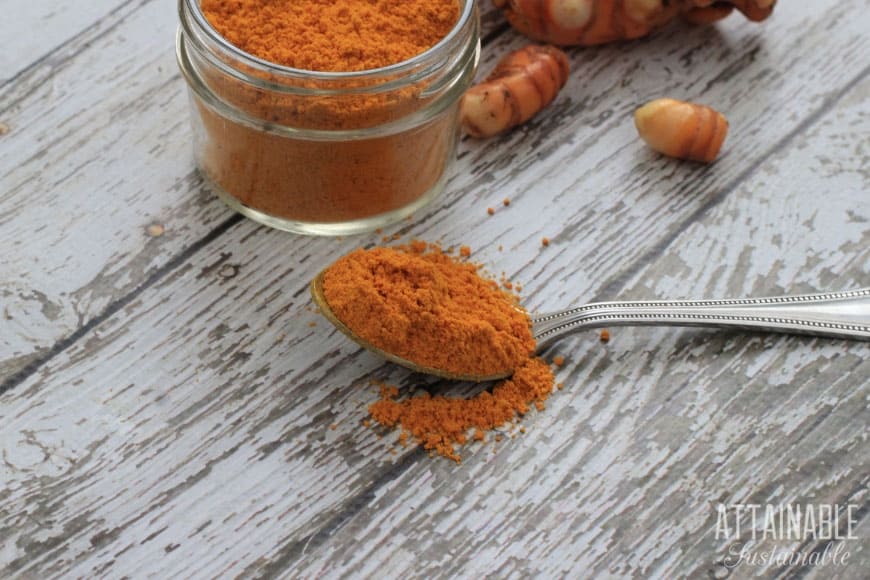
Originally published November 2018; this post has been updated.

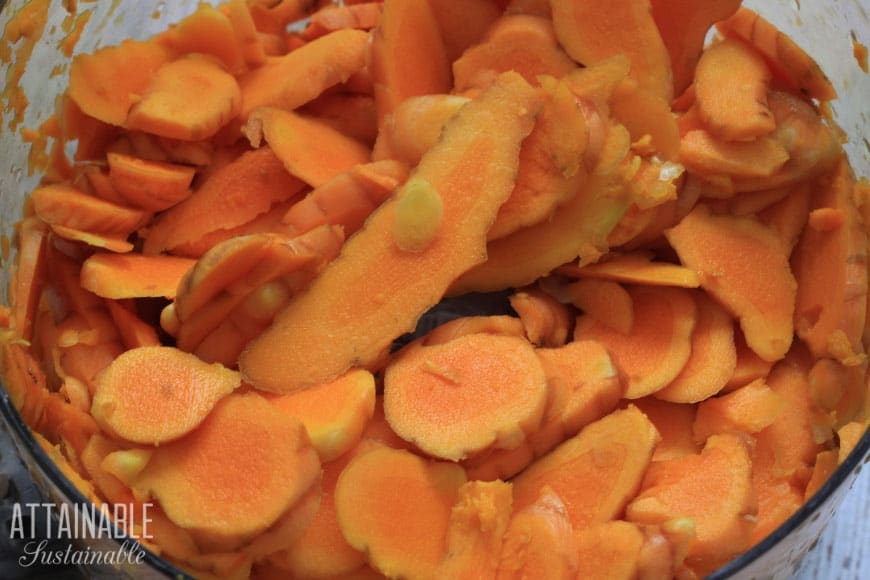
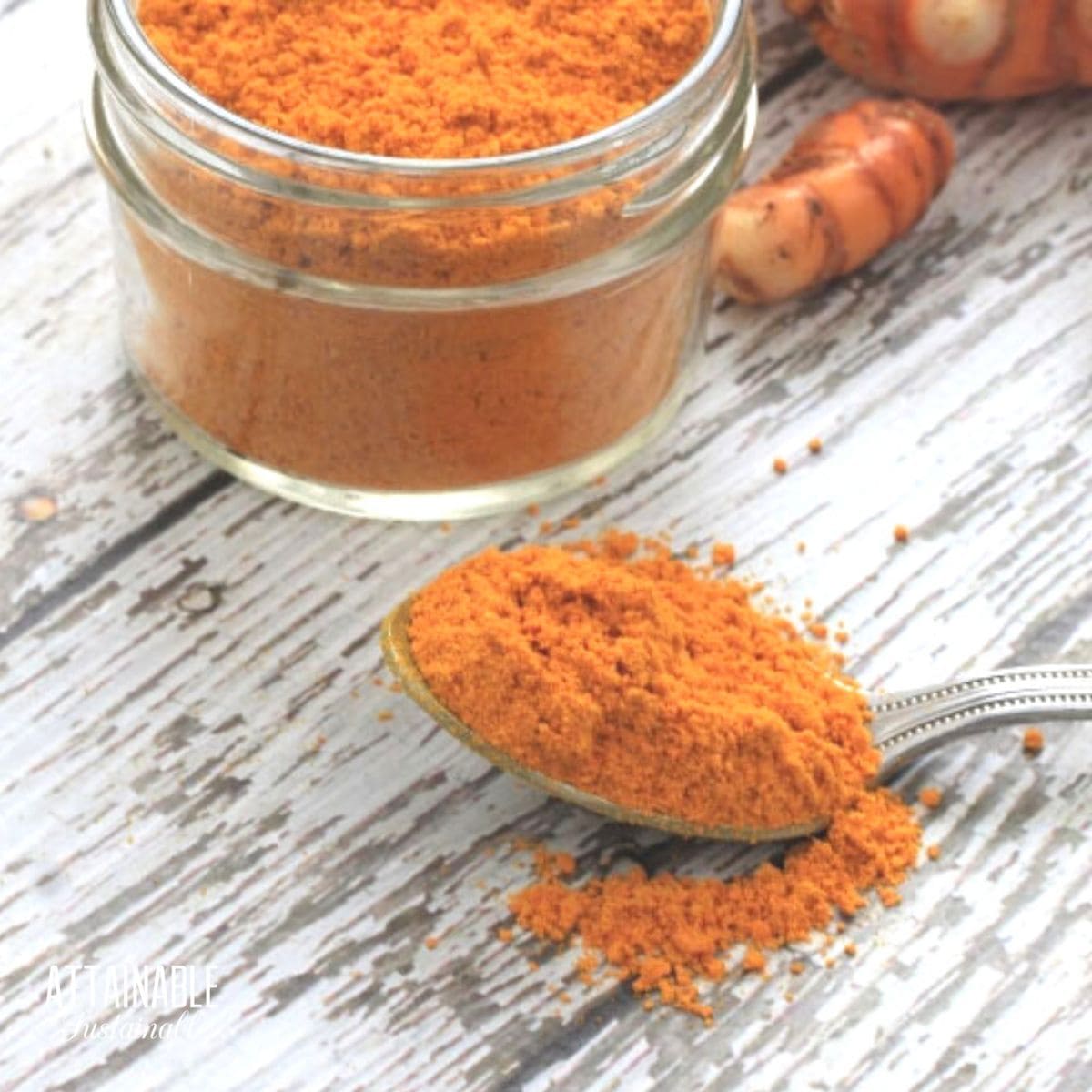
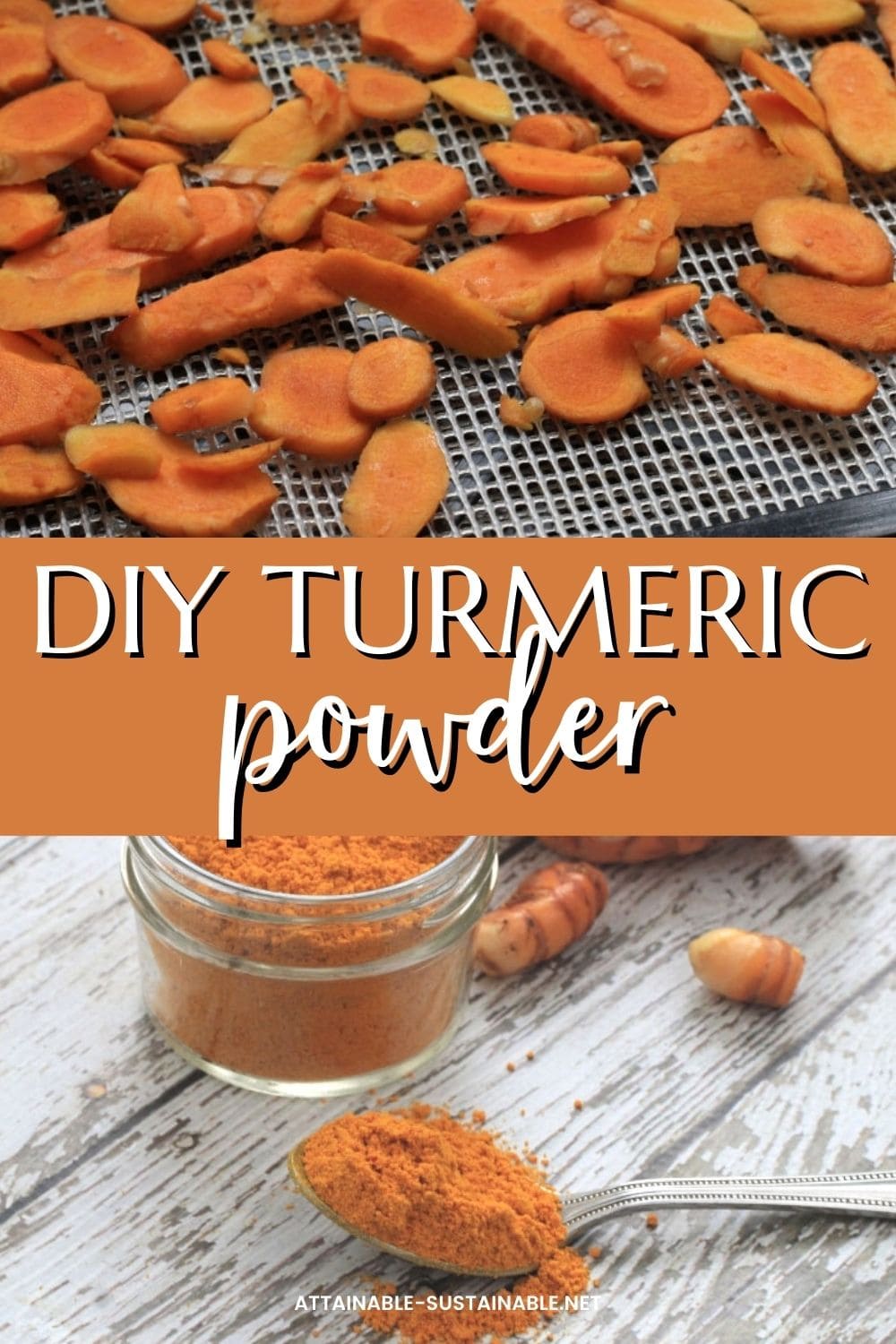





What is an alternative to a dehydrator?
An oven set to the lowest temperature will work!
What is the dosage for taking turmeric for medicinal purposes.once you have the powder made. ?
Since that’s highly variable, it is not something I can advise you on.
I have to get started. As soon as I can acquire some roots!!! Thank you…
I’ve been wanting to do this forever but finally have my hands on a borrowed dehydrator! Like many preserving chores, I can’t exactly call this a time saver. On the flip side, there is great satisfaction in knowing this is all my work product – from start to finish (except the borrowed dehydrator). I know exactly where my spice came from and how it was processed. I’ll always take pride in these accomplishments, knowing I spared carbon by doing it myself (we have solar PV, so as long as I do anything requiring electricity during a sunny day, it’s “free”). And you can’t get any fresher! The flavor is amazing. Thanks Kris!